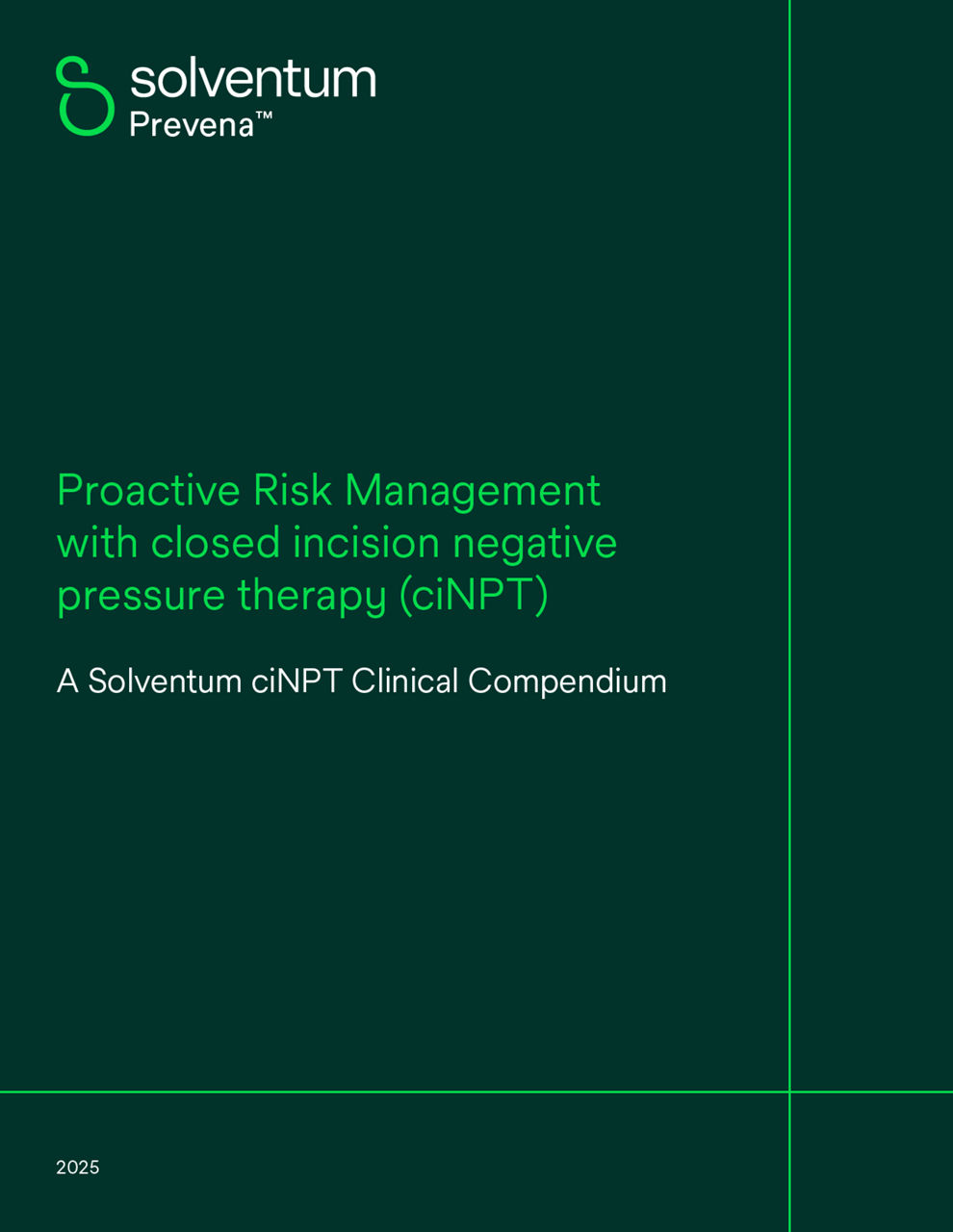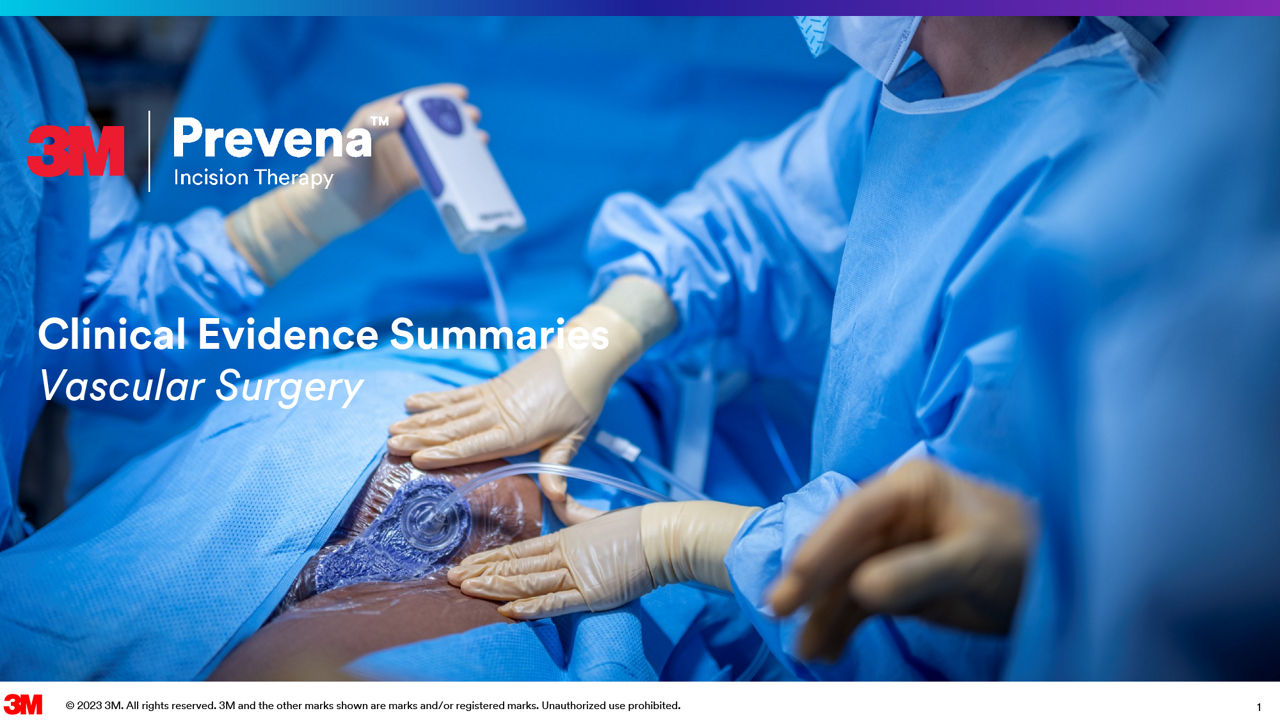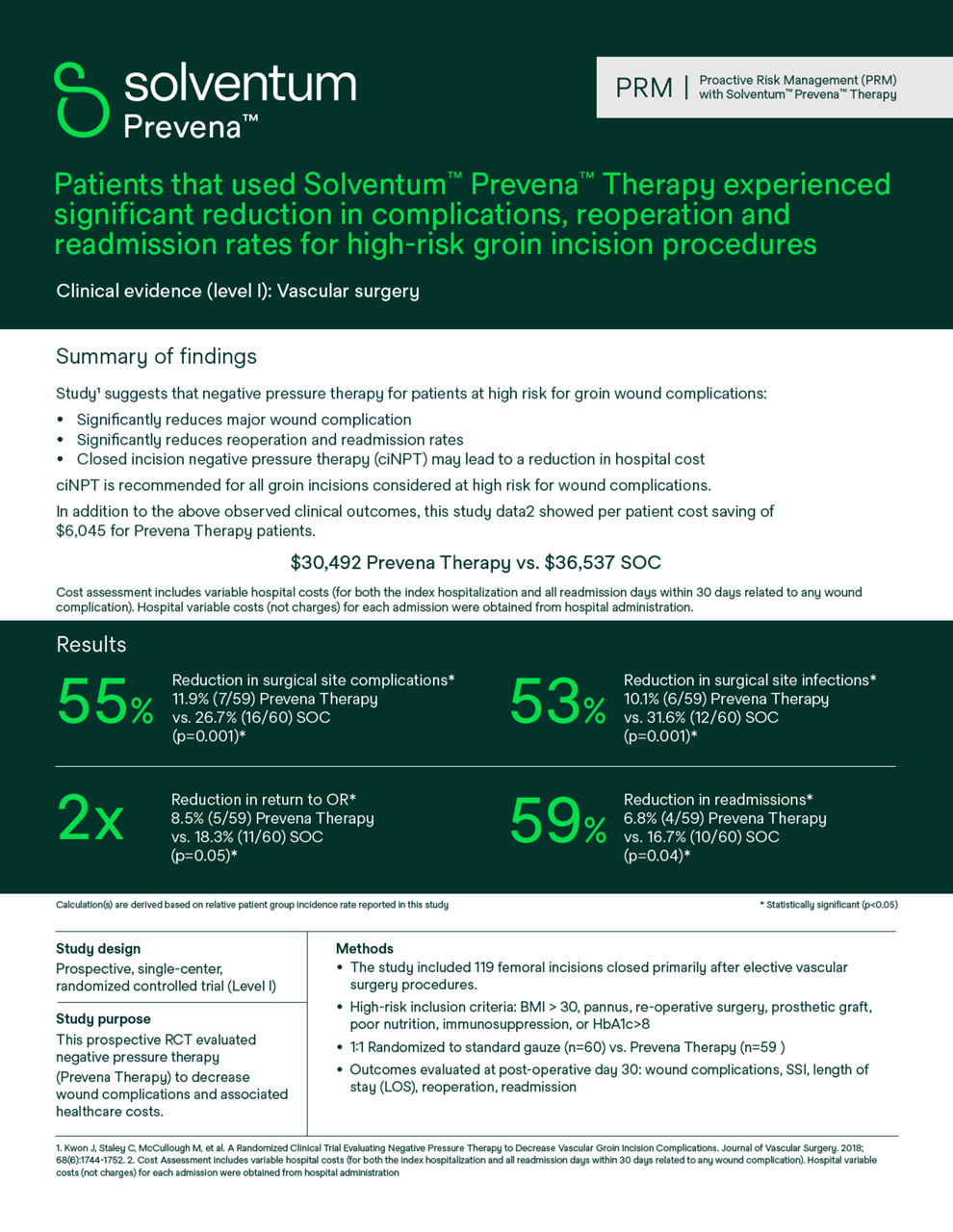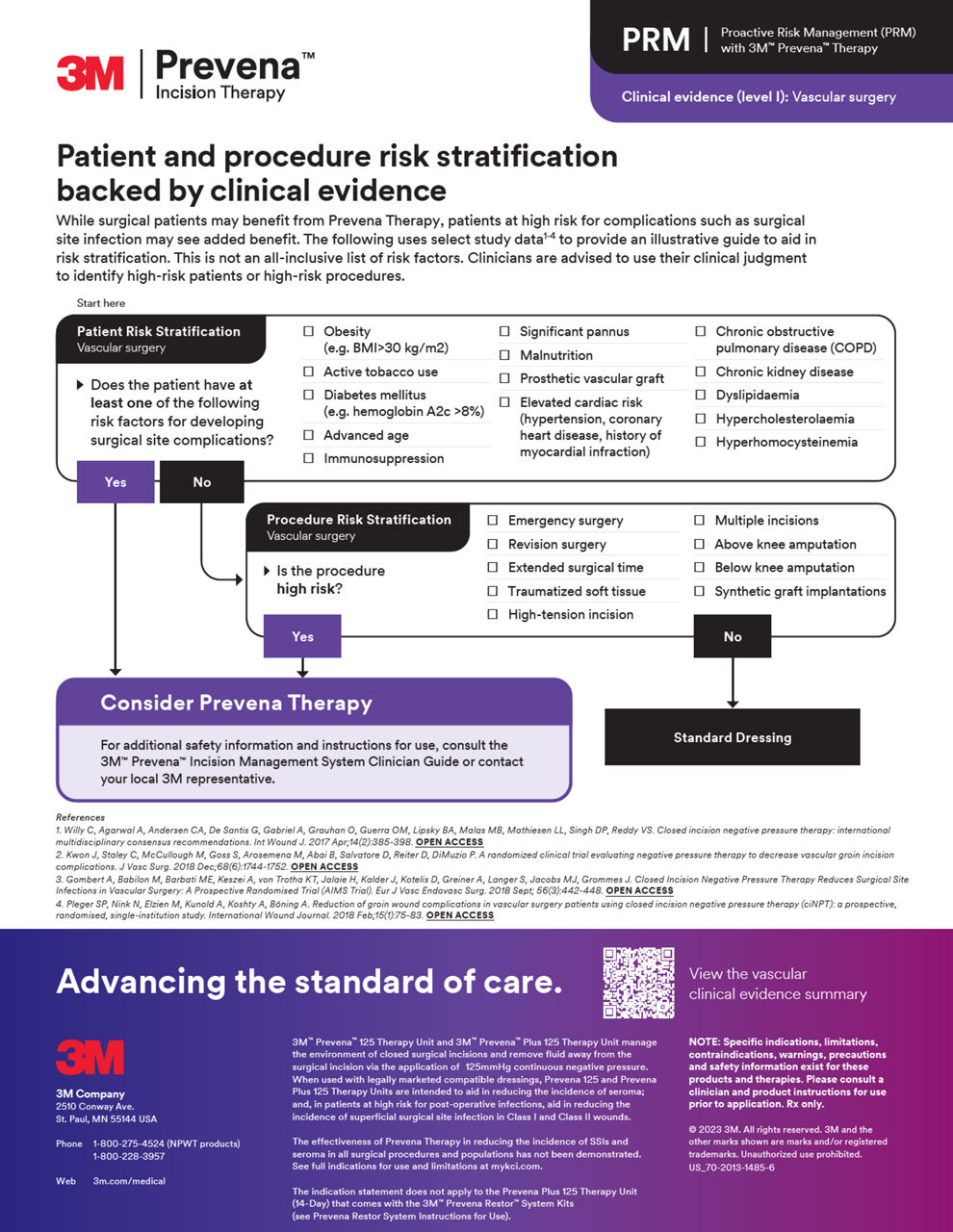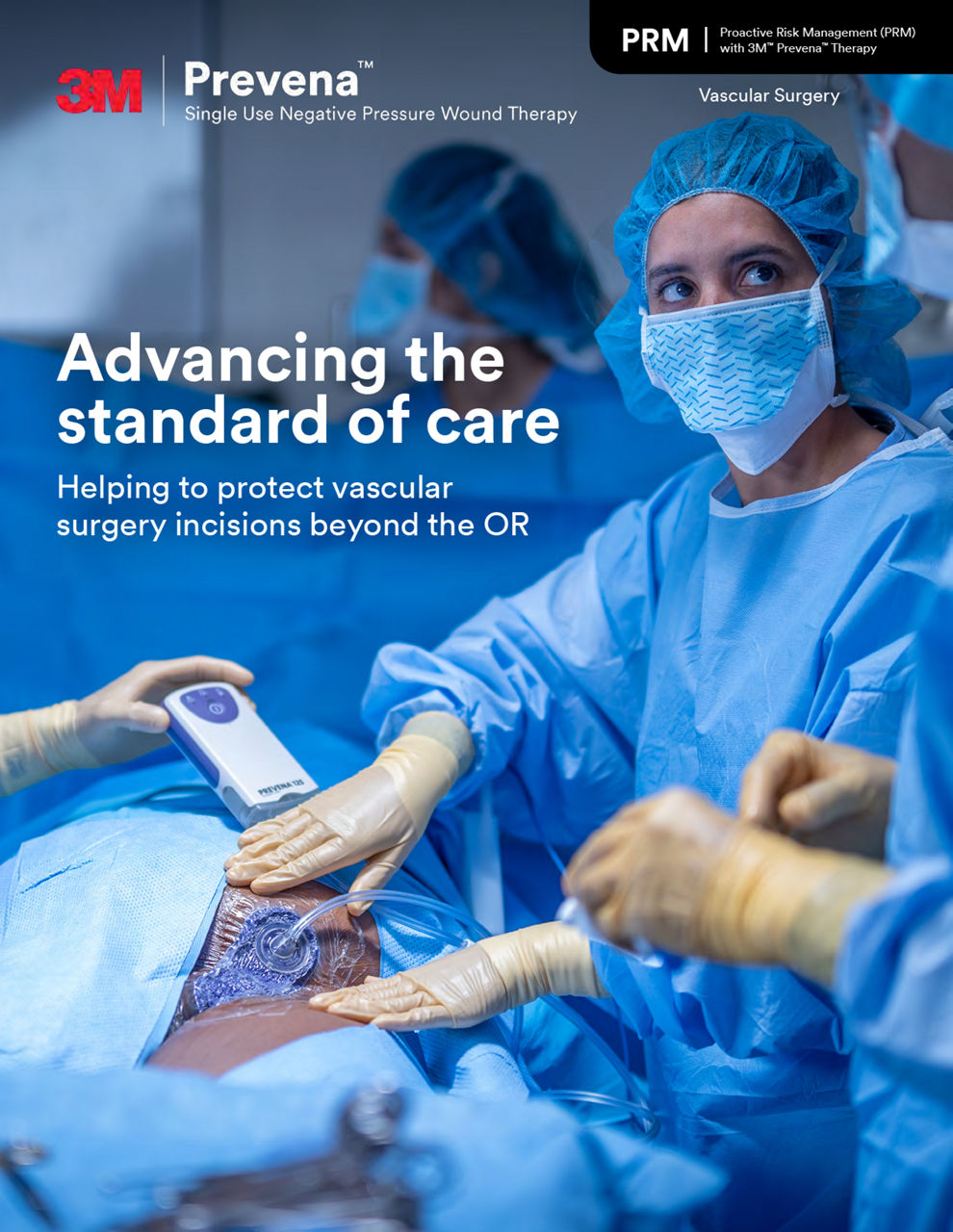3M Prevena Therapy for vascular surgery
Enhanced vascular surgery outcomes with Prevena Therapy
A systematic review and meta-analysis of 6 studies for vascular surgery procedures demonstrated that 3M™ Prevena™ helped significantly reduce the risk of various surgical site infections (SSIs), revision surgeries and shorter hospital length of stay.
*Risk-reduction is calculated based on Risk Ratio derived from related Odd Ratios and Prevalence Rate.
†Calculation(s) are derived based on the relative patient group incidence rate reporting in this study. Statistically significant (p<0.05).
**Difference in means.
The effectiveness of Prevena Therapy in reducing the incidence of SSIs and seroma in all surgical procedures and populations has not been demonstrated. See full indications for use and limitations at hcbgregulatory.3M.com.
Proactive risk management (PRM)
Access comprehensive resources to implement PRM into your practice with Prevena Therapy, helping elevate your standard of patient care with proven postoperative benefits.
Prevena Therapy video resources
Explore more
Abstracts
Discover abstracts from prominent research papers on topics related to Prevena Therapy, offering valuable scientific findings and perspectives.
- A randomized clinical trial evaluating negative pressure therapy to decrease vascular groin incision complications
- Utilizing closed incisional negative pressure therapy reduces peripheral bypass infection rates without increasing costs
- Closed incision negative pressure therapy reduces surgical site infections in vascular surgery: A prospective randomised trial (AIMS trial)
- Closed incision negative pressure wound therapy may decrease wound complications in major lower extremity amputations
- Deep learning-based risk model for best management of closed groin incisions after vascular surgery
- Meta-analysis and trial sequential analysis of prophylactic negative pressure therapy for groin wounds in vascular surgery
- Reduction of groin wound complications in vascular surgery patients using closed incision negative pressure therapy (ciNPT): a prospective, randomised, single-institution study
Explore more
Product information
Explore detailed resources including brochures, coding sheets and other informational resources offering comprehensive insights into Prevena Therapy for vascular surgery.
Abstracts
Discover abstracts from prominent research papers on topics related to Prevena Therapy, offering valuable scientific findings and perspectives.
- A randomized clinical trial evaluating negative pressure therapy to decrease vascular groin incision complications
- Incidence and impact of surgical site infections on length of stay and cost of care
- Utilizing closed incisional negative pressure therapy reduces peripheral bypass infection rates without increasing costs
- Closed incision negative pressure therapy reduces surgical site infections in vascular surgery: A prospective randomised trial (AIMS trial)
- Closed incision negative pressure wound therapy may decrease wound complications in major lower extremity amputations
- Deep learning-based risk model for best management of closed groin incisions after vascular surgery
- Meta-analysis and trial sequential analysis of prophylactic negative pressure therapy for groin wounds in vascular surgery
- Reduction of groin wound complications in vascular surgery patients using closed incision negative pressure therapy (ciNPT): a prospective, randomised, single-institution study
NOTE:
Specific indications, limitations, contraindications, warnings, precautions and safety information exist for these products and therapies. Please consult a clinician and product instructions for use prior to application. Rx only.
Indication(s) For Use / Intended Use: US FDA Cleared: Only for Use in the United States:
Prevena Dressing used with Prevena Therapy Units: PREVENA™ 125 and PREVENA PLUS™ 125 Therapy Units manage the environment of closed surgical incisions and remove fluid away from the surgical incision via the application of -125mmHg continuous negative pressure. When used with legally marketed compatible PREVENA™ dressings for up to seven days, PREVENA™ 125 and PREVENA PLUS™ 125 Therapy Units are intended to aid in reducing the incidence of seroma; and in patients at high risk for post-operative infections, aid in reducing the incidence of superficial surgical site infection in Class I and Class II wounds.
Limitations:
- The device is not intended to treat surgical site infection or seroma.
- Safety and effectiveness in pediatric population (<22 years old) have not been evaluated.
- Safety and effectiveness in Class III (Contaminated) and Class IV (Dirty/Infected) wounds have not been demonstrated. Furthermore, Class IV surgical wounds are not expected to be closed primarily, and the subject device should only be used on closed surgical incisions.
- The device has not been demonstrated to reduce deep incisional and organ space surgical site infections.
The device has not been demonstrated to be effective in reducing the incidence of surgical site infection and seroma in all surgical procedures and patient populations; therefore, the device may not be recommended for routine use to reduce the incidence of surgical site infection and seroma. - Please refer to the ‘Summary of Clinical Information’ section for the specific surgical procedures and patient populations included in the clinical studies. Surgeons should continue to follow the ‘Centers for Disease Control and Prevention Guideline for the Prevention of Surgical Site Infection’2 and the ‘American College of Surgeons and Surgical Infection Society: Surgical Site Infection Guidelines’3 for best practices in preventing surgical site infection. US FDA Cleared: Dressings/ Systems (Prevena Dressings used with compatible Solventum NPWT units - ActiVAC, Ulta, and RX4) and applicable OUS countries that leverage US Indication: The PREVENA™, PREVENA PLUS™, PREVENA DUO™, and PREVENA RESTOR™ Incision Management Systems are intended to manage the environment of surgical incisions that continue to drain following sutured or stapled closure by maintaining a closed environment and removing exudates via the application of negative pressure wound therapy.
References:
- Antoniou G, Onwuka C, Antoniou S et al. Meta-analysis and trial sequential analysis of prophylactic negative pressure therapy for groin wounds in vascular surgery. J Vasc Surg 2019; 70 (5):1700-1710.
- Berríos-Torres, S. I., Umscheid, C. A., Bratzler, D. W., Leas, B., Stone, E. C., Kelz, R. R., Reinke, C. E., Morgan, S., Solomkin, J. S., Mazuski, J. E., Dellinger, E. P., Itani, K. M., Berbari, E. F., Segreti, J., Parvizi, J., Blanchard, J., Allen, G., Kluytmans, J. A., Donlan, R., & Schecter, W. P. (2017). Centers for Disease Control and Prevention guideline for the prevention of surgical site infection, 2017. JAMA Surgery, 152(8), 784. https://doi.org/10.1001/jamasurg.2017.0904
- Ban, K. A., Minei, J. P., Laronga, C., Harbrecht, B. G., Jensen, E. H., Fry, D. E., Itani, K. M. F., Dellinger, P. E., Ko, C. Y., & Duane, T. M. (2017). American College of Surgeons and Surgical Infection Society: Surgical Site Infection Guidelines, 2016 update. Journal of the American College of Surgeons, 224(1), 59–74. https://doi.org/10.1016/j.jamcollsurg.2016.10.029

